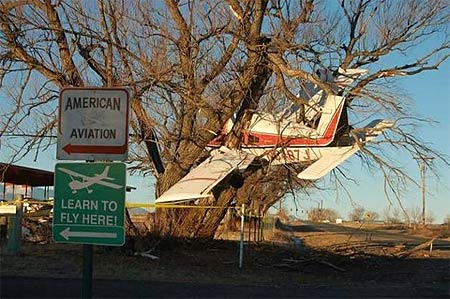Learning to Fly Blind
...sort of

When learning to fly, and even after for many, we tend to expect someone or something to tell us what to do it when we are learning anything. The speedometer in your car tells you how fast you're driving. Your watch tells you precisely what time of day it is. Your scale tells you how much you weight, although I'm sure its off by 30 pounds. But do you really rely on them to tell you exactly how your doing? When you drive you glance at the speedometer occasionally to make sure you're doing the speed you think you're doing and you usually are. Your watch confirms that its the end of another day and it usually is. Your scale confirms that you need to get another scale, that's rarely true.
Too many people, while learning to fly, expect to do everything according to the instruments and what they are telling them. In IFR conditions its necessary but in VFR you can do very well without them. In fact you might find that you can do better without them. And, who knows, one day they may decide to do without you so practicing in those conditions might come in handy.
You've heard of flying by the seat of your pants. It is exactly what it sounds like. Listen to your pants. You shouldn't have to look at the ball to tell the the rudder isn't coordinated. Your pants are telling you "Hey, I'm about to slide out of the seat here, add some rudder!" Learn to become One with your pants.
The same can be said for speed. At a given power setting, the nose of the aircraft will be a the same place for a given speed. When you are power off on final, the visual picture of the nose of the aircraft will be the same at a given speed. Need to change airspeed? Change the position of the nose, up for slow down for fast. Learn what that looks like.
When you are learning to fly your instructor will show you how the airplane stalls. Its not to show you that at 48 miles per hour the airplane will stall. Its to show you how the airplane looks, nose ridiculously sky high, how it feels, controls sloppy, and how it feels as it actually stalls. You don't need the airspeed indicator to tell you the airplane is going to stall.
We tend to rely so heavily on the instruments telling us something we forget to learn how to really fly the airplane. Since I have been teaching, I have harped on getting pattern speeds on the money. What I have noticed in my own flying is that without looking at the airspeed indicator, I am nearly dead on the speeds by just doing what looks right. I have actually covered the airspeed indicator with a post-it note with a student flying, resulting in some of his best landings ever. By not keeping your eyes fixed on the airspeed indicator you won't be chasing the airspeed and your primary attention becomes landing the airplane smoothly and not "is my airspeed ok".
Last year, after completing the annual on the RV8, I washed the airplane and then flew to Lubbock to pick up a passenger. Once in the pattern, I started to slow the plane down to the proper airspeed. As I slowed down, the speed just didn't seem to be coming down regardless of what I did. I knew I hadn't flown the RV in a while and maybe it was a perception thing. But still, the airspeed didn't seem to go below 90. Then I realized there was a problem with the airspeed indicator, possibly due to washing something into the static port. So now, paying close attention to how the airplane was flying instead of relying on the non functional airspeed indicator, I made some of the best landings I've ever made in the RV.
When learning to fly VFR, learn to see and feel the airplane. Use the instruments to confirm what you think is happening, you might find you can do well without them.
back to Learning to Fly
Sport Pilot Stuff home